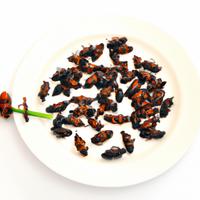
1 serving (50 grams) contains 250 calories, 22.5 grams of protein, 17.5 grams of fat, and 4.0 grams of carbohydrates.

Log this food in SnapCalorie

Nutrition Information
Calories |
1182.9 | ||
|---|---|---|---|
% Daily Value* |
|||
| Total Fat | 82.8 g | 106% | |
| Saturated Fat | 23.7 g | 118% | |
| Polyunsaturated Fat | 0 g | ||
| Cholesterol | 236.6 mg | 78% | |
| Sodium | 709.8 mg | 30% | |
| Total Carbohydrates | 18.9 g | 6% | |
| Dietary Fiber | 4.7 g | 16% | |
| Sugars | 0 g | ||
| protein | 106.5 g | 213% | |
| Vitamin D | 0 mcg | 0% | |
| Calcium | 189.3 mg | 14% | |
| Iron | 11.8 mg | 65% | |
| Potassium | 946.4 mg | 20% | |
* Percent Daily Values are based on a 2,000 calorie diet. Your daily values may be higher or lower depending on your calorie needs.
Food Attributes
Source of Calories
About Fried insects
Fried insects are a protein-packed, nutrient-rich food consumed in various regions worldwide, particularly in Asia, Africa, and Central and South America. Commonly enjoyed varieties include crickets, grasshoppers, silkworms, and mealworms, prized for their crispy texture and mild, nutty flavor. These edible insects are rich in protein, healthy fats, essential vitamins such as B12, and minerals like iron and zinc, making them a sustainable, eco-friendly alternative to traditional protein sources. Fried insects are often prepared with seasonings or spices, reflecting the diverse culinary traditions they originate from. While their high protein and nutrient content are beneficial, potential drawbacks include high sodium levels from seasoning and potential allergies for some individuals. Fried insects are also popular for their low environmental impact, as farming insects requires significantly less water, land, and resources than raising livestock.



